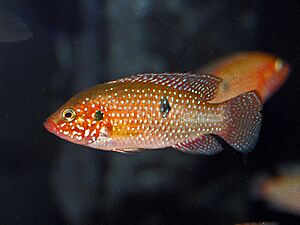Hemichromis lifalili facts for kids
Quick facts for kids Hemichromis lifalili |
|
|---|---|
 |
|
| Hemichromis lifalili | |
| Conservation status | |
| Scientific classification | |
| Synonyms | |
|
The Hemichromis lifalili, also known as the blood-red jewel cichlid, is a beautiful type of fish. It belongs to the Cichlidae family, which includes many popular aquarium fish. This fish is well-known for its amazing bright red color!
Contents
About This Fish
The Hemichromis lifalili can grow to be about 8 to 10 centimeters long. That's roughly the length of a small hand! These fish are usually red-orange or bright red. They have rows of tiny blue spots all over their body, head, and fins. You might notice two dark spots on their sides. One spot is near their gills, and the other is in the middle of their body. Unlike some other jewel cichlids, they don't have a dark spot near their tail.
Male vs. Female Fish
During mating season, almost the entire body of the fish turns bright red. Outside of this time, you can tell males and females apart by their body shape. Females are usually thinner and show a brighter red color. Males are stronger and have a bigger head than females.
What They Eat
These fish are not picky eaters! They mostly feed on small animals like worms, tiny crustaceans, and insects. They also enjoy eating small fish. Besides meat, they will also eat some plant material.
Reproduction and Life Cycle
The blood-red jewel cichlid is a popular fish for aquariums. Many people like to breed them at home because it's quite easy. When it's time to lay eggs, the female usually places about 400 eggs on a stone. The male then fertilizes them right away. If the water temperature is around 25.5 degrees Celsius, the eggs will hatch in about 48 hours. After about five and a half days, the baby fish, called fry, start swimming freely. The female fish mostly takes care of leading the fry around. The male fish spends his time defending their territory from other fish.
Where They Live
This fish lives in the Democratic Republic of the Congo. You can find them in the Lower and Central Congo River basin. However, they are not found in the Shaba (Katanga) and Kasaï regions. These fish prefer warm watercourses that have rocks. The water temperature they like is usually between 22 and 24 degrees Celsius. You won't find them in water that doesn't have much oxygen, or in very fast-moving rapids, or in swampy areas.


